
11 minute read
Whole Foods Marktet
BY ELENA SULLIVAN
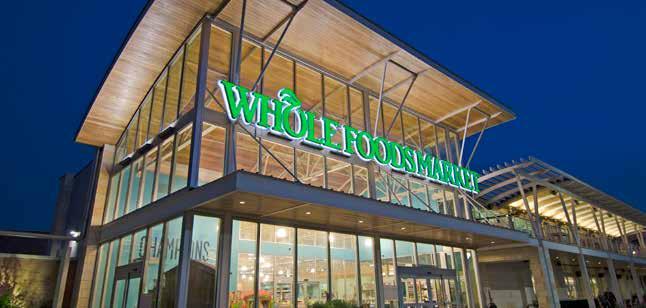
WHAT’S NEXT FOR WHOLE FOODS?
Whole Foods Market, the world’s largest natural foods grocery chain, headquartered in Austin, Texas, was founded in 1980. Whole Foods established the supermarket concept in natural and organic foods retailing and offers a variety of healthconscious foods that boast attributes such as non-GMO, vegan, vegetarian and gluten-free ingredients. The company operates more than 500 stores throughout the US, Canada, and the UK. Whole Foods offers shoppers an impressive array of private label products and approximately 55% of its private label brand offerings are either certified organic or “Non-GMO Project Verified.” The retailer markets its main private label under the Whole Foods Market and 365 by Whole Foods Market labels. Other private label brands include, but are not limited to, Allegro Coffee, Whole Paws, and Engine 2 Plant-Strong. Whole Foods has made several acquisitions and retail initiatives over the years, adding to its profile organic retail outlets and brands including Wellspring Grocery, Mrs. Gooch’s, Fresh Fields, Bread of Life, and Merchant of Vino. Its largest purchase took place in 2007, with the acquisition of 109 Wild Oats Markets. In 2016, the retailer tried out a new initiative geared towards shoppers looking to buy organic and natural items at a value, opening its first stores under the new name 365 by Whole Foods. The 365 stores—named for the Whole Foods’ private label, were smaller and carried less expensive merchandise than the company’s regular outlets. However, in 2017, Whole Foods revamped its board as the company faced continued declining sales.
Craig Weller Renee Lawson Hardy John Mackey
Shortly thereafter, Whole Foods was acquired by online retail giant, Amazon. The deal, which was valued at more than $13 billion, closed in August, 2017. Amazon was intent on revamping Whole Foods image as a retailer that only offered products at premium prices. The online retailer soon closed the 365 stores and began lowering prices in regular Whole Food Market locations. Other changes followed. Whole Foods’ products were folded into Amazon’s e-commerce platform and Amazon Prime became part of Whole Foods’ rewards program. Amazon also updated its logistics and merchandising operations with the goal of lowering prices even further and also added several features into the Whole Food stores which would garner attention from existing Amazon shoppers who might not yet be Whole Food customers. For example, Amazon Lockers were installed in select Whole Foods locations, enabling shoppers to pick up and return online orders from Amazon.com. Additionally, expanding on its own grocery delivery operations, Whole Foods ended its partnership with Instacart in early 2019 and now utilizes Amazon Fresh and AmazonPrime for its deliveries.
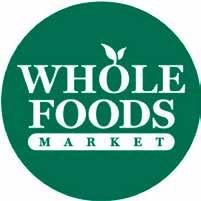
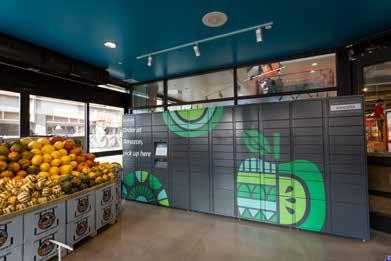
A Boost from Amazon:

Whole Foods is constantly innovating and adapting to consumer preference with several e-commerce and online initiatives just in recent months. The merging of Amazon and Whole Foods also boosted both Whole Foods’ online presence and its private brands. Prior to Amazon’s acquisition of Whole Foods, the retailer did have an E-commerce presence, however, Amazon’s enormity has enabled Whole Food products to be more widely available. In 2018, Whole Foods expanded its Prime Now delivery and pickup services to additional locations, with plans to continue expansion across the US. Delivery is available in more than 60 cities and grocery pickup is available in nearly 30 cities. Whole Foods products can be found for delivery through Amazon.com or for online ordering and pick up in-store on Wholefoodsmarket.com.
Last Spring, the onset of the Covid 19 Pandemic ignited a flurry of e-commerce initiatives to satiate consumers who wanted grocery delivery or pick-up options due to stay-at-home orders. Whole Foods temporarily converted several of its locations across the country that saw a significant drop in foot traffic, to online-only operations, but now all but a couple have opened up for in-person shopping. However, Amazon and Whole Foods were perhaps ahead of the market, they had already broken ground in fall of 2019 on a permanent online-only store to expand its capacity to fulfill online orders.
According to a blog post by Amazon, in September 2020, Whole Foods opened its first ever permanent online-only store in Brooklyn, NY. According to the retailer, the store is dedicated to fulfilling only online orders, allowing its team members to “quickly receive, shop, and prepare orders for delivery to more customers than ever before.” The online-only store delivery is exclusively available to customers in Brooklyn. Whole Foods also began an additional online shopping perk in October 2020. Driven by the increase in online shopping and grocery pick-up due to the Pandemic, the retailer introduced, free, one-hour pick-up on orders $35 or more from Whole Foods Market for all Prime members. Members can simply go to the Amazon.com App or visit the website and start shopping. Once they are ready to check-out, customers can choose a one-hour pick-up window that is convenient for them. According to Amazon, this initiative was spurred by the increasing number of new online grocery shoppers in the past year. The company noted that “more than 40 percent of Whole Foods Market pickup orders each month are from customers trying the service for the first time.” Amazon also provides data for the lasting interest in grocery pick-up, quoting from Global Data Research stating that “almost 68 percent of consumers say they will continue to use curbside pickup even when the pandemic has subsided.”
Diving deeper into the grocery delivery arena and competing closely with delivery companies such as Instacart, Amazon recently announced its plan to roll out a new delivery program for Whole Foods Market stores called Shop and Deliver. The retailer describes the new program where Amazon Flex delivery partners shop at Whole Foods and then deliver orders to customers. The Flex drivers would operate as independent contractors, similar to delivery services such as Uber or Instacart. Amazon has provided detailed information on its website to orient prospective Flex drivers to the job tasks as well as more complex shopping requests such as what to do if an item is out of stock or in a different location, or purchasing items by weight such as deli or meat packages or bulk items.
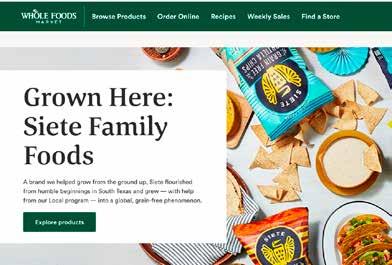
Online Collaborations
Whole Foods has also delved into a couple of online collaborations that highlight its private label products. In August 2020, Whole Foods launched Home Ec 365, “a digital curriculum designed to modernize the fundamentals of home economics.” The company describes the initiative as offering a series of virtual classes to help viewers master everyday home tasks and necessary life skills ranging from “creative baking swaps and transforming food scraps to stocking up on grocery staples and choosing the right cleaning products.”
To help prepare for the virtual classes, Whole Foods Market offers exclusive coupons for free products for those who enroll. The products are Whole Foods Market private label, 365 brand items that will be needed for the classes. The classes have themes such as “Swap-Savvy Baking: Getting Creative with Recipes & Replacements,” “Use ‘Em Up! How to Transform Food Scraps & Leftovers,” and “Smarter Shopping: Save, Stock & Invest – The right ingredients go a long way in the kitchen.” Another online initiative recently launched by Whole Foods is a collaboration with Mindfulness app Headspace, to support well-being for mind and body. The collaboration provides a collection of mood-enhancing recipe videos, meditations and mindful exercises to promote mindful eating. After a year that has been undoubtedly stressful for many people, the need for mindfulness is more apparent than ever. A recent Harris poll conducted on behalf of Whole Foods indicated that customers were increasingly interested in improving their wellbeing, eating more mindfully, and feeling more connected to food. Subsequently, the teaming up of Whole Foods, a retail leader in food geared towards health, and Headspace, a well-known meditation app that focuses on mindfulness was only natural. The initiative entails a new wellness series, which includes four “food for mood” episodes available on the Whole Foods Instagram TV channel, each featuring a recipe geared towards mood enhancement, created by Chef, Food and Welfare Advocate, Sophia Roe and Harvard nutritional psychiatrist, chef and author of This Is Your Brain on Food, Dr. Uma Naidoo. Customers can also take advantage of three new free Headspace meditations on mindful shopping, cooking and eating, as well as a free one-month trial of Headspace Plus. Furthermore, many of the recipes feature Whole Foods brand products, a clever marketing tool, drawing attention to the healthy and versatile attributes of its private label.
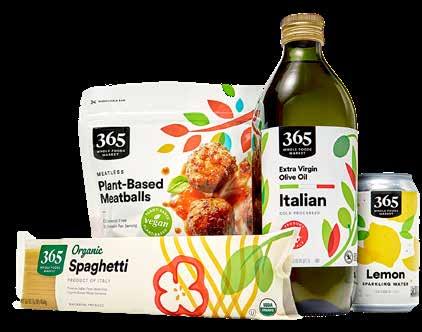
Brand Refresh
Alongside Whole Foods Market’s many recent innovative initiatives that have promoted its private label products, a refresh of its 365 private brand has also appeared in store and online. The change is subtle yet perhaps foreshadows more changes to come in the future. The 365 Everyday Value brand now reads 365 by Whole Foods Market and the redesign of its packaging features clean, bold lines and colors. The 365 brand is available in Whole Foods stores and on Amazon. Whole Foods website also details the benefits of purchasing the 365 brand alongside promotion for the Home Ec 365 by Whole Foods Market digital curriculum.
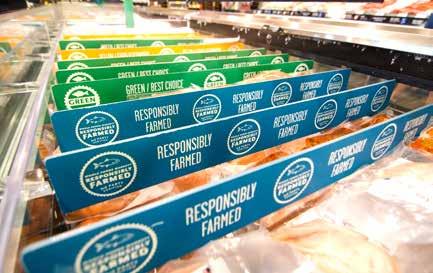
There have been many musings as to why the refresh, and some experts indicate that the change is an attempt by Amazon to consolidate and streamline the Whole Foods Market’s brands. As noted earlier, when Amazon acquired Whole Foods Market, it quickly shuttered the stand-alone 365 retail locations as a way to focus more energy on the traditional Whole Foods Market locations and online operations, so this change in branding also fits into Amazons’ efforts to look at what is working and what isn’t, and act accordingly.
Sustainability Trends Maintain Speed
Health and wellness and sustainability trends are front and center at Whole Foods, and the retailer constantly strives to improve its practices. As witness, a few years ago, the retailer pledged that by 2018, all products in its stores in North America would be labeled to indicate if they contain GMOs. However, that pledge was changed in 2018 to state that Whole Foods would not promote a product as non-GMO unless it has been verified by a third party.
Continuing with its efforts, in April 2021, the retailer launched its Sourced for Good program, which is an exclusive thirdparty certification program to support responsible sourcing of foods, including seafood. According to the retailer, the program aims to make improvements in farm workers’ lives, strengthening worker communities where products are sourced, and encouraging environmental stewardship where crops are grown. The Sourced For Good seal can be found on more than 100 products at WholeFoods Market stores, including items such as vegetables and flowers. The retailer plans to include its seafood products, and currently the first seafood product featuring the seal is Del Pacifico wild-caught shrimp from Mexico. According to Whole Foods, the Sourced For Good program replaces the retailer’s Whole Trade Guarantee. Whole Foods Market’s Sourced for Good program includes products certified by organizations such as Fair Trade USA, Rainforest Alliance, Fairtrade America, Fair Food Program, and Equitable Food Initiative. The Sourced For Good seal enables shoppers to quickly identify products that fall under these measures. Whole Foods understands that many shoppers want to purchase products that are sourced sustainably but have difficulty determining which products adhere to specific rules. Therefore, the seal makes it simple for customers to identify sustainably sourced products while shopping.
Future Innovations
While Whole Foods Market on its own was a powerhouse in the natural and organic food space, with Amazon, it is reaching entirely new heights and many parallel innovations are being seen across the board. For example, Amazon just recently announced the launch of its Amazon One payment option at Whole Foods Market, at one Whole Foods Market location in Seattle, Washington and will soon be available in seven locations in Seattle in the coming months. Amazon One, “a fast, convenient, contactless way for people to use their palm to enter, identify, and pay,” was introduced at Amazon store locations last year and enabled shoppers to quickly and efficiently pay with just their hand. The system allows customers to associate a credit card with their palm print and provides a contact-less alternative to cash and card payments. According to the retailer, customers who are new to the service can quickly sign up in participating stores. They are also able to link their Prime account to automatically receive their Prime membership discounts at the Whole Foods location. Arun Rajan, senior vice president of technology and chief technology officer at Whole Foods Market commented on Amazon’s website: “At Whole Foods Market, we’re always looking for new and innovative ways to improve the shopping experience for our customers,” he continues, “Working closely with Amazon, we’ve brought benefits like Prime member discounts, online grocery delivery and pickup, and free returns to our customers, and we’re excited to add Amazon One as a payment option beginning today. We’re starting with an initial store at Madison Broadway in Seattle and look forward to hearing what customers think as we expand this option to additional stores over time.” This newest initiative sums up the power and strength of the partnership between Whole Foods and Amazon, and it seems as if the sky's the limit for both companies. We are sure to see many more innovations in the future.








